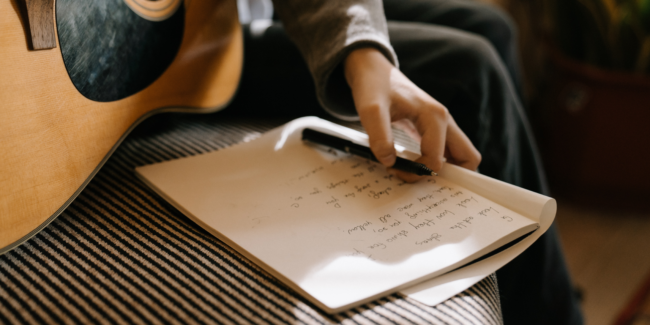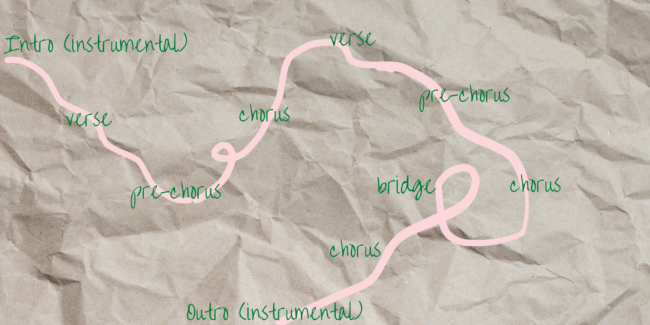6 Music Industry Secrets that Make Songs Sound More Original

Do the songs you write end up sounding like something you heard on the radio? Here are some insider tips for making your songs sound more original.
On Spotify alone, there are more than 50 million songs. As a songwriter, this can be very daunting.
How will I ever make my songs stand out?
Songs express the human experience – it’s what makes them resonate with us. Finding your way of sharing these experiences is how you discover a unique voice as a songwriter.
We’ve gathered information from pros to help you bend and break songwriting conventions. Use these tips and tools to craft your songs into gems that sound more original, memorable, and from the heart.
The spark and the mechanics.
Before we get into the hot tips, we need to clarify two distinct parts of songwriting.
The first is the “spark,” or the moment of inspiration where an idea just flows out of you. It could be a rhythm, riff, or lyric that you can’t get out of your head.
When you’re in the spark it’s super important just to let the creativity flow. Write down or record what you hear in your head unashamedly -without hesitation – even if it feels simple or unoriginal.

The second part of the process is the “mechanics,” or the analysis phase. The mechanics are where you go over whatever came out during your spark moment and look at it with an analytical eye.
An analysis is challenging for songwriters because it can trigger self-judgment and harsh criticism. Try to stay gentle and patient in your approach and remember that songwriting can be nourishing and meaningful.
The following tips apply best during the mechanics stage. When you’re in the spark phase, your only job is to get out of the way! Let the music move through you and reassure your mind that it will get an opportunity to apply itself later.
1. Play with form
The form is arguably the most important element of songwriting. It creates the shape of the listener’s journey. In Western music, most songs follow the same sort of form. You can trace this form back to classical music of the 19th century.

You can fiddle with this form to dramatically change your listener’s experience by doing things like:
- Starting the song with a pre-chorus – After the pre-chorus, you can lead straight into a verse, creating a sort of ‘prologue’ feeling.
- Ending the song on a verse – Ending on a verse gives the song a sense of coming full circle.
- Making it a double-chorus – A double-chorus is when you play the chorus twice in a row. For a twist, use a slight variation the second time around.
- Ending the song with a bridge – By holding off on the final chorus everyone anticipates, you leave the listener wanting more.
2. Change up the melody and harmony.
In the spark moment, we often use the simplest and most accessible ways of expressing what we hear in our heads. Sometimes the magic is in the simplicity.
Other times, we need to put on our music theory hats and think about how we can add spice and flavor to add nuance to the musical story. Here are some tricks to keep in your pocket:
Create a melodic sequence
This is when you play a melody a second time with a slight variation. For example, the first line of your verse might use the following notes: A, D, C#; E, F#, G#.
Instead of repeating this melody again on the second line – put the whole phrase up by a major third interval.
So it would look like this: C#, F#, E; G#, A, B. Because the line’s shape and rhythm are the same, it will give a similar feeling to the original melody, with just an extra sprinkle of pzazz.
Switch a major chord progression for a parallel minor progression
If your song is in the key of C major, the classic 2-5-1 progression will look like this: Dm7, G7, Cmaj7.
Choose one or two of the times you play this progression in your song to switch it out for a minor 2-5-1 progression.
In the case of C, we have Dmin7b5, G7b9, and Cm. This will give your song a surprising twist of darkness and add depth to your listener’s experience.
Are you a little stuck on music theory? Here’s a quick refresher on notes and chords to get you up to speed.
3. Improvise a section or two.
There is a lot of value in perfecting a song. But at the end of the day, music is an art that happens in real-time.
Choosing defining moments in your song for free expression can be a sure-fire way to engage the listener and keep the song alive over time.

A good moment for improvisation could be in the bridge. The listener has usually heard the verse and chorus twice by this point, so something with less structure can be refreshing for the ears.
Another excellent opportunity for a solo is after the first chorus. This can help create tension and suspense before giving the listener the relief of hearing the verse and chorus again.
4. Combine metaphors with realism.
Songwriting experts claim that the best songs have a perfect mix of lofty metaphorical language and realistic, day-to-day descriptions. However, it’s not easy to find this balance.
Too much metaphor
Your eyes were like a fire
My heart was like a drum
My mind was blowing with the wind
While I was chained to my desire
Too much realism
Your eyes were staring at me
My heart was beating very fast
My thoughts were racing and scattered
I hoped the feeling wouldn’t last.
A good balance
You looked at me with fire
The drums beat in my chest
I couldn’t help but think of you
You chained me to desire.
5. Use different rhyming patterns.
There is something very soothing about a rhyme. We feel relief and satisfaction when we hear someone express an idea musically. But if you overuse a rhyme pattern, it becomes repetitive and predictable.
Here are some examples of different rhyming techniques which you can use throughout your song to make it exciting and dynamic.
Rhyme on lines one and four
This slightly unconventional rhyming pattern creates tension during lines two and three as the listener waits for the rhyme.
We sat by a river bed
And spoke about what’s next
I promised not to leave
And not to take back what I’ve said.
Uneven rhyming
Usually, the last word of each sentence rhymes. Try rhyming words in the middle of the sentences, or a word in the middle with a word at the end.
You were like a brother
But a deal, we could not strike
Another wheel is turning
That’s the burning that we feel

6. Add a spoken section.
It can be tricky to mold everything you want to say into the rhythmic constructs of a melody in a verse or chorus.
These days, we see more and more artists using the spoken word as a tool for having more space and time to tell their stories. It will also allow you to introduce a new character or a new tone of voice into the song.
A good moment for a spoken section could be in the bridge. Another popular placement is in the outro, as a sort of dream sequence which leads the listener to the end of the song.
It’s essential to have different tools and tricks for developing and crafting your songs. In the end, what an audience wants to hear is you.
Try to make your songwriting voice as authentic as possible. That means talking about real feelings and having moments where you write as if you were speaking to your best friend.
It means singing the music in your heart and not overcomplicating what you hear for the sake of being original.
Remember that songwriting is a lifestyle, and you have forever to keep improving. If you are more of a producer than a songwriter, check out these tips for avoiding a generic production sound.









